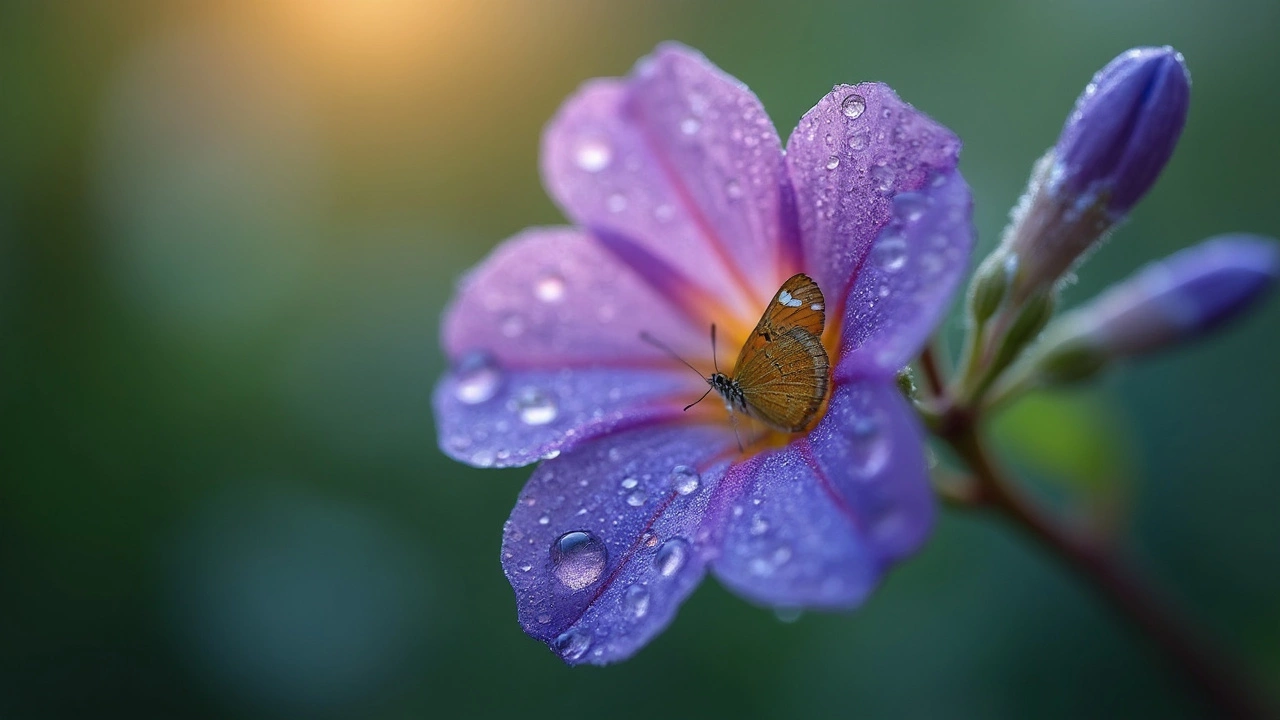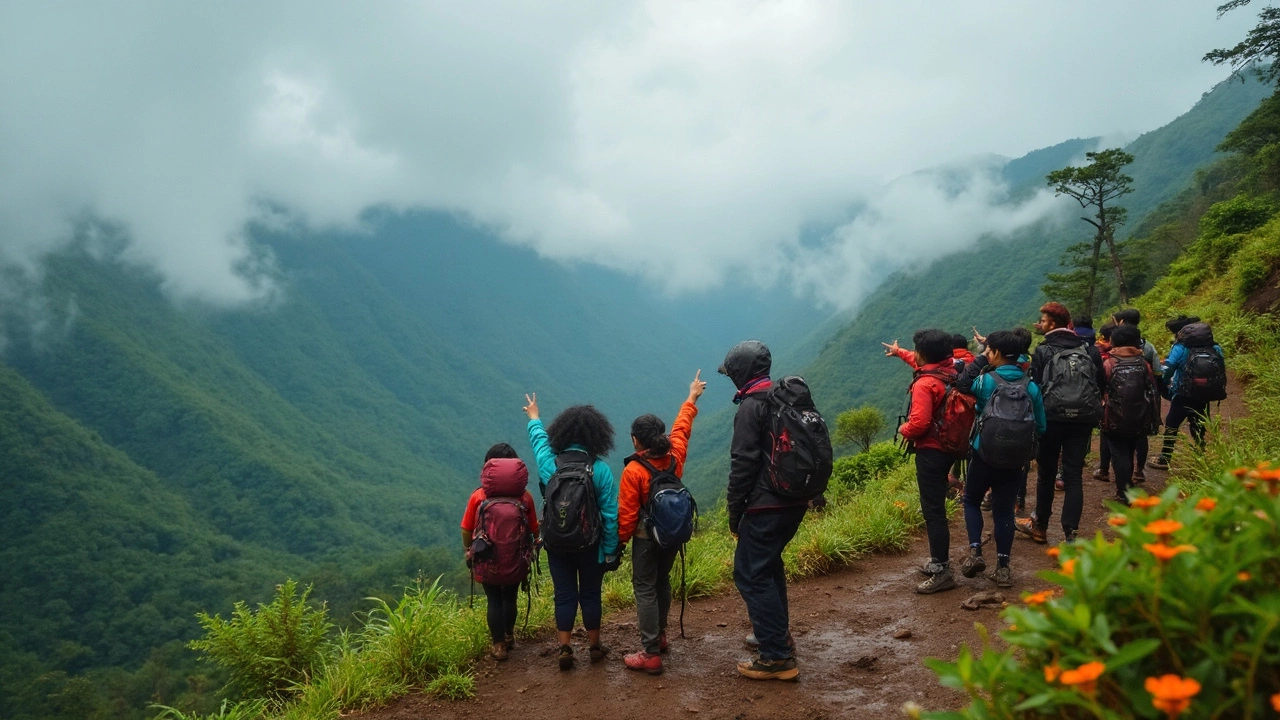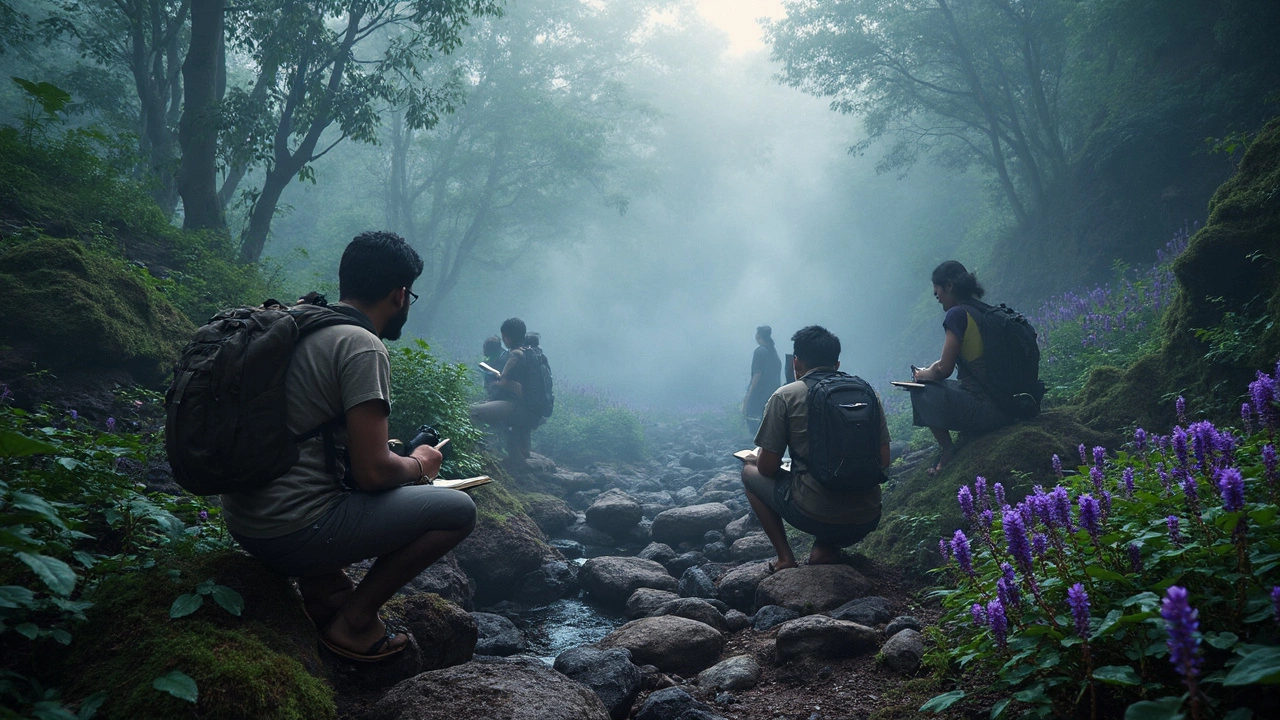Picture this: a flower that only shows up once every twelve years, transforming hills into a sea of blue. That’s the Neelakurinji—a plant so rare, locals and travelers alike plan their entire year around its big reveal. If you’re thinking of rare Indian plants, it doesn’t get more exclusive than this.
You might think it’s just a flower, but Neelakurinji (Strobilanthes kunthiana) plays a starring role in India’s seasonal plant scene. It’s the plant version of a solar eclipse: you’ll need serious luck or planning to see it in full bloom. So why does it only pop up every twelve years? What makes it tick? Let’s pull aside the curtain and see how this elusive plant fits into India’s wild plant puzzle—and how you can actually catch it in action.
- Meet the Superstar: Neelakurinji
- Where and When Does It Bloom?
- Why Is It So Rare?
- Conservation Challenges and Efforts
- Tips for Spotting Neelakurinji in the Wild
Meet the Superstar: Neelakurinji
If you've never heard about the Neelakurinji, you're in for a surprise. This plant, known officially as Strobilanthes kunthiana, is a bit of a legend in southern India. It's not just rare; it's also got a quirky habit—rare plant India fans love it because it blooms once every twelve years. That is not a typo, it's really a once-in-12-years deal.
Found mainly on the rolling hills of the Western Ghats, especially around Munnar in Kerala and parts of Tamil Nadu, Neelakurinji covers the slopes in bluish-purple flowers when it finally decides to show up. Local people and tourists actually track and plan for this major event. When it last bloomed completely in 2018, thousands flocked to the hills to catch the spectacle.
This isn’t just a pretty plant either. There are more than 40 species of kurinji, but Strobilanthes kunthiana is the poster child. Botanists have tracked its cycle closely because it has a very precise natural clock—almost all the plants in an area bloom together, literally transforming landscapes overnight.
Here’s a quick glance at what makes Neelakurinji stand out:
| Trait | Detail |
|---|---|
| Native Region | Western Ghats (mostly Kerala & Tamil Nadu) |
| Bloom Cycle | Once every 12 years |
| Flower Color | Bluish Purple |
| Botanical Name | Strobilanthes kunthiana |
| Last Mass Bloom | 2018 |
If you're wondering why it's so special, the answer is simple: scarcity and timing. Seeing these flowers in person takes commitment, which makes it a big deal among plant lovers and travel enthusiasts. Next expected full bloom is in 2030, so there's time to plan if you want in on the show.
Where and When Does It Bloom?
Neelakurinji is basically a celebrity among India's wildflowers, and people travel from all over just to witness its rare spectacle. The plant hangs out mostly in the shola grasslands of the Western Ghats, especially in Kerala, Tamil Nadu, and Karnataka. To be precise, the most famous spot is the Eravikulam National Park near Munnar in Kerala. When Neelakurinji decides to bloom, these hills shift into a rolling blue landscape—something photos just can't do justice.
Now for the timing, here's the twist: this plant has a super weird habit. It flowers only once every 12 years. Yep, that's right. The last massive bloom was in 2018, so mark your calendar—the next mass flowering should hit around 2030. In the meantime, you'll see a handful of scattered blooms, but the hills only explode into full blue glory once per cycle.
“During the Neelakurinji season, visitor numbers at Eravikulam National Park often jump by over 60%. It’s a once-in-a-generation phenomenon,” says Rajan Kumar, ecologist at Munnar Biodiversity Office.
Take a look at where and when you can expect this marvel:
| Location | Main Bloom Period | Best Viewing Spots |
|---|---|---|
| Eravikulam National Park, Kerala | August–October, every 12 years | Rajamala Hills, Anamudi slopes |
| Kodaikanal, Tamil Nadu | August–September, same cycle | Upper Palani Hills, Vattakanal |
| Bababudangiri, Karnataka | August–September, rare/patchy blooms | Western ridge trails |
If you ever want to catch this event, plan ahead. The window for full bloom doesn’t last more than a couple of months, and the hills get crowded with both travelers and locals. Your best bet: get there early in the season and aim for the protected park zones for the clearest views and most vibrant patches. If you're a nature photographer, this is the shot you don't want to miss.

Why Is It So Rare?
The Neelakurinji's rarity isn't just hype—it’s built into the plant’s DNA. For starters, it follows an unusual blooming cycle called “plietesial,” which means it blooms just once every twelve years. Imagine waiting your whole life for one shot at the spotlight. That’s about the vibe here.
Here’s what makes things even trickier: the Neelakurinji is picky about where it grows. You’ll mainly find it on the shola grasslands of the Western Ghats, especially around places like Munnar and Kodaikanal. The plant doesn’t like being moved, so you won’t find it in your backyard or a city park. Its exacting needs—right altitude, exact climate, and even the right kind of soil—make the odds even shorter.
And there’s more. Once it blooms, every plant in the rare plant India story dies and the cycle starts over with seeds. If anything messes up the pollination (think forest fires, grazing, or rogue weather), the next generation may not even start. That’s a massive risk every twelve years.
Habitat loss is probably the biggest threat to Neelakurinji. The Western Ghats are ground zero for deforestation, land conversion, and tourism pressure. Loss of grasslands directly wipes out these plants. In fact, studies from Kerala’s Department of Forests show that the area covered by Neelakurinji shrank by almost 23% over the last twenty-five years due to these problems.
| Factor | Impact on Rarity |
|---|---|
| Blooming Cycle | Only once every 12 years |
| Habitat Restriction | Western Ghats' shola grasslands |
| Habitat Loss (last 25 yrs) | Area reduced by ~23% |
| Pollination Failures | Can lead to entire cycles being missed |
So, if you’re thinking of chasing the Neelakurinji, now you know why it’s not just another wildflower. Its rarity is literally baked in and the odds are stacked for a huge comeback—or a major gap—every twelve years.
Conservation Challenges and Efforts
The fight to protect Neelakurinji is a real uphill climb. These blue blossoms may look invincible when they fill the hills, but the truth is, they're under serious threat. Most of their natural area in the Western Ghats has been eaten up by expanding tea plantations, tourism build-out, and forest fires. Back in the early 2000s, it was reported that almost 23% of their habitat had already vanished. That number is worse now, with townships slowly creeping over the hills where these plants should grow wild.
One thing that makes Neelakurinji especially vulnerable is its unique way of blooming—all at once, then gone for another twelve years. If something wipes out the plant one year, it won’t just bounce back next season. And since it's so rare, pollinators and seeds have an even harder job spreading the next generation.
But there’s hope. Conservationists and local groups stepped up hard during the 2018 bloom, working alongside Kerala’s forest department. They roped off key hills, upped patrols, and set rules to keep tourist traffic under control. You’ll find big warning signs at entry points and, if you visit, you’re often required to stick to marked trails only.
Here’s a quick look at some key measures and facts:
- Neelakurinji was officially protected when the Kurinjimala Sanctuary was formed in 2006, covering around 32 square kilometers specifically to save its habitat.
- During bloom years, visitor numbers are capped to prevent trampling and littering in core areas.
- Local NGOs run awareness workshops for nearby villages and schools, focusing on better fire prevention and eco-friendly tourism.
If you want numbers, check out this table that highlight major threats and solutions:
| Threat | Action Taken | Results |
|---|---|---|
| Habitat loss (plantations, tourism build-up) | Sanctuary established, restricted new construction | Slowed down major land conversion |
| Forest fires | Increased firewatch, community fire drills | Drop in severe fire incidents in 2018 |
| Uncontrolled tourism | Visitor caps, strict entry controls | Less trampling, cleaner bloom sites |
If you’re hoping to see this plant in the wild, the best move is to always follow posted rules, avoid picking flowers, and leave no trash behind. The more careful we are, the better chance Neelakurinji has to show off once again in 2030.

Tips for Spotting Neelakurinji in the Wild
If you want to witness the legendary Neelakurinji bloom, you need to get your timing and location just right. Some plants bloom every year, but this one, not so much. Miss the window, and you’ll wait over a decade for the next shot.
First off, here’s where most people get to see the rare plant India keeps talking about:
- Munnar, Kerala is the most popular spot—the hills literally turn blue during the bloom.
- You’ll also find patches in the Western Ghats, especially on the Kodaikanal and Nilgiri hills in Tamil Nadu.
- Smaller, scattered blooms sometimes pop up in Karnataka’s Chikmagalur region, but nothing beats Munnar’s spectacle.
The last major bloom happened in 2018, and the next expected mass bloom is around 2030. If you’re up for a hike, plan your visit anytime between July and October when the flowers usually open up. Don’t just show up at random—research local forecasts. Some tour operators even give live updates when the season is about to kick off.
Here are some useful steps to boost your chances:
- Start prepping early—hotel bookings in bloom hotspots fill up months in advance.
- Travel with a guide or a local if you’re not familiar with the hills. Trails can get confusing, and the best blooms may be off the tourist path.
- Gear up for the weather: Monsoon rains make the Western Ghats muddy and slippery, so pack good boots and rainwear.
- Always respect the rules—stick to marked trails and don’t pluck flowers. The whole ecosystem depends on leaving things as you find them.
Most visitors spend a day or two exploring, but true flower chasers (yes, that’s a thing!) might head up at sunrise for crowd-free photos. Some local nature clubs organize walks and photography tours with real-time updates on the best spots.
Quick need-to-know stats for spotting Neelakurinji:
| Location | Prime Bloom Months | Accessibility |
|---|---|---|
| Munnar (Kerala) | July – October | Easy by car/bus, many hotels |
| Kodaikanal (Tamil Nadu) | August – September | Good roads, several viewpoints |
| Nilgiri Hills (Tamil Nadu) | August – September | Less crowded, some trekking required |
And remember, aside from its beauty, the Neelakurinji bloom is a big deal for local communities—so going with the flow and being respectful goes a long way. If you catch the bloom, you’ll be part of a pretty exclusive club who’ve seen India’s natural wonder in action.

